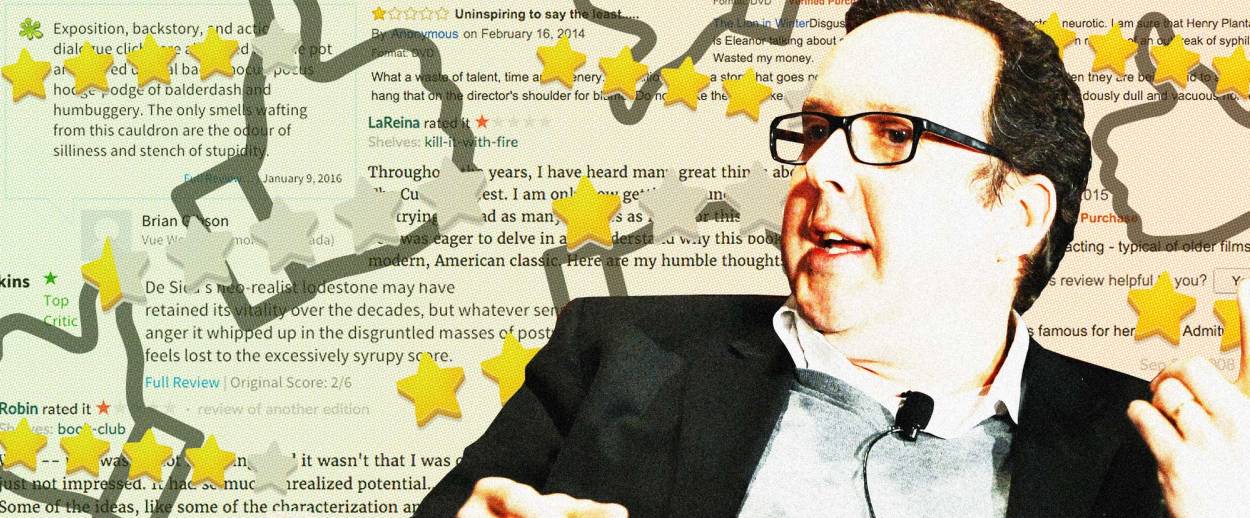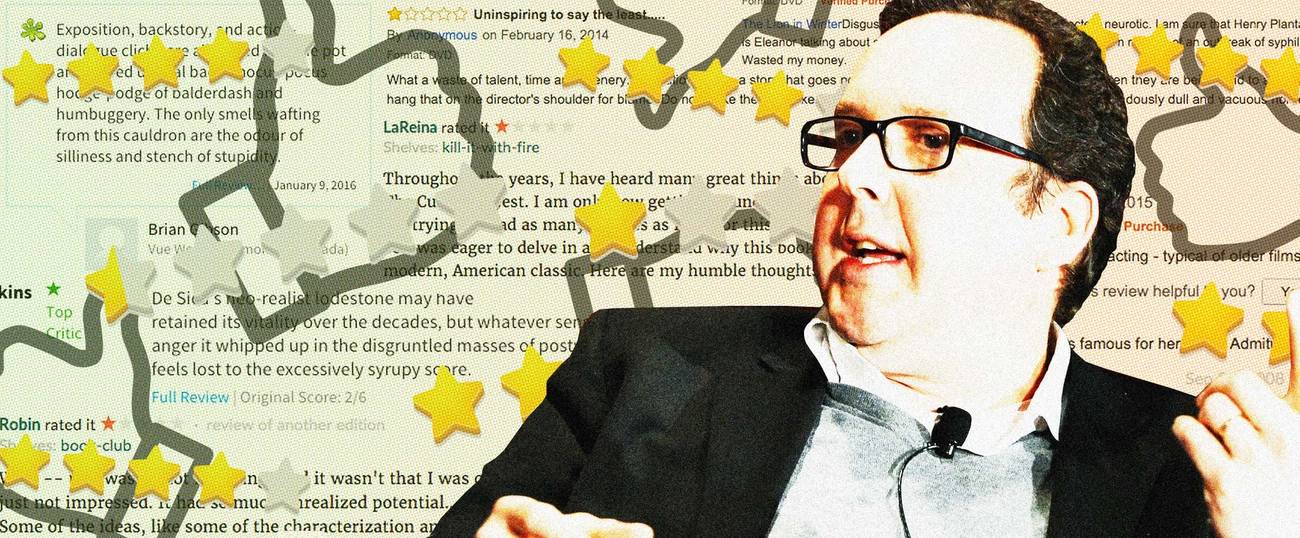Better Living Through Criticism
A.O. Scott’s defense of considered opinions comes just as the culture needs it most




In 1948, Stanley Edgar Hyman, best remembered today as the husband of the writer Shirley Jackson, published a book titled The Armed Vision, a survey of contemporary literary criticism. Remarkably, Hyman was no scholar—he was a staffer at The New Yorker—and he was writing for a popular audience, not an academic one. The hundreds of thousands of readers who made best-sellers of books like Lionel Trilling’s The Liberal Imagination, or Edmund Wilson’s Axel’s Castle could turn to The Armed Vision (a paperback!) to learn who was who in what Randall Jarrell, himself an important critic, wryly called “The Age of Criticism.” Hyman wasn’t writing just criticism, he was writing criticism of criticism; yet he did so with a conviction that he was performing a primary literary activity.
Jarrell was complaining about the Age of Criticism, not praising it. He deplored the way ambitious young people, in the mid-20th century, wanted to write criticism instead of novels and poems. He complained that the critics’ consensus narrowed the range of literary discussion, so that everyone was constantly talking about the same half-dozen canonical books. But as Jarrell also said, in a golden age, everyone goes around complaining about how yellow everything looks. I don’t think he would have been happier in our own time, when serious criticism is increasingly thin on the ground, even as various other technologies of ranking and assessment proliferate. And it’s not just literary criticism that has changed: Few if any critics today have the charisma of Kael and Farber, Bangs and Willis.
What happened? Surely it’s not that people stopped caring about movies and music, or stopped talking about them. On the contrary, fandom is a more respectable condition than ever before; obsessive devotion to sci-fi or hip-hop is now the foundation of identity for millions of people. And of course the Internet has made it easier than ever for fans to find those who share their particular passions. But perhaps the decline of the critic and the rise of the fan are connected; and both are surely connected to the displacement of literature from the center of culture.
Criticism, even when it is not literary criticism, is a literary activity—it is a kind of writing. A culture indifferent to writing will be indifferent to criticism. And criticism is addressed not to fans, but to independent minds, people who express their enthusiasms through debate and analysis rather than dogged collecting and esoteric one-upsmanship. (An online Star Wars forum is a good place to discuss whether Episode I is better than Episode II; it’s not a good place to discuss whether Star Wars matters in the first place.)
To gauge how far the position of criticism in our culture has changed, you only have to compare The Armed Vision to Better Living Through Criticism, the new book by A.O. Scott, the chief film critic of the New York Times. Scott has written a manifesto in defense of criticism, rather than a work of criticism itself, and that is already a significant difference. It is only beleaguered genres—poetry, say, or jazz—that inspire apologies and defenses; popular and confident genres simply go about their business. But there is always a paradox about such apologies, which has to do with their audience. People who simply don’t read or care about criticism won’t read a defense of it, and people who are already committed to criticism don’t need it defended. Who, then, is the writer trying to convince?
This uncertainty about audience is the most important and symptomatic fact about Better Living Through Criticism. It appears most clearly as a problem of reference, which is always an issue in criticism. A critic must assume a certain community of knowledge with the reader, or else the argument can never get started. But Scott is hesitant to take for granted any prior literary or historical knowledge on the part of the reader. No matter who or what is mentioned—Kant, H.L. Mencken, Henry James, Louis XIV—he introduces it with a journalistic tag: e.g., “Moby-Dick, [Melville’s] grand, tragic, philosophically ambitious narrative of an ill-fated whaling voyage.” This says both too much—who is the potential reader of Scott’s book that doesn’t know Moby Dick is a whale?—and too little—if you haven’t read Moby-Dick, three adjectives aren’t going to give you any real sense of it.
The problem of knowledge is also a problem of authority. The critic claims the authority to set the terms of reference in the discussion—she implies that certain things ought to be known, are worth knowing, for instance the significance of Moby-Dick. The unavoidable implication is that, if the reader doesn’t know them, he must learn them, or else he will not be able to take full part in the discussion. This kind of authority can be deployed aggressively, even meretriciously. T.S. Eliot, for one, loved to drop allusions to obscure Elizabethan playwrights, in an off-hand way that implied that everyone spent their evenings debating the finer points of Beaumont and Fletcher’s versification. But authority has to be claimed in some way, at some point, or else the critic forfeits any right to the attention of the reader.
Scott shows himself to be deeply anxious about claiming any kind of authority. He is clearly a very intelligent, thoughtful, deeply read critic; there is no doubt that he does know Kant, Mencken, James, and so forth. Yet whenever it comes time to give a judgment on a particular issue, he abstains. The rhythm of the book owes much to deconstruction: Binaries are constructed and then allowed to cancel each other out, so that nothing is left but a demonstration of the impossibility of certainty.
In his six briskly paced chapters, Scott raises many of the perennial questions about criticism. Is criticism parasitic on creation? Is the critic malicious, a failed artist? Why listen to the critic’s opinion rather than anyone else’s? Does the critic hope to make a right judgment about a particular work, and if so, how can we judge its rightness? In each case, Scott’s answer is a version of “yes and no.” Should a critic join the consensus or fight it? It hardly matters, since “time blunts the edges of argument and banks the fires of opposition.” Who was right in the canon wars, traditionalists or innovators? “It was never a matter of choosing between Shakespeare or Toni Morrison … but rather of making room for both.” Elsewhere he writes, in what could be the motto of the book, “It is neither necessary nor possible to choose between these positions—choosing is the primal and inevitable mistake of criticism, the gesture that calls it into being.”
No wonder the most important chapter of the book is titled “How To Be Wrong.” It is impossible, Scott writes, “to declare a decisive allegiance, to cast one’s lot with the party of form or the party of content, the armies of tradition or the rebel forces of modernity, the clique of skeptics or the church of enthusiasts.” Either way, you end up wrong, by which Scott really seems to mean controvertible. And it’s true that the process of criticism is endless, because it is always possible to make a rejoinder to any final judgment. Was John Donne a great poet? In the 17th century he was, in the 18th he wasn’t, in the 20th he was again; who knows what the 22nd century will say, provided humanity is still around.
If a critical judgment is always wrong, however, it is also at the same time always right. That is because criticism doesn’t aim for, and isn’t capable of, accuracy, in the way that you can accurately solve a multiplication problem. Rather, it aims for truthfulness: Criticism is the truthful statement of a perspective on the world. In this sense, it is close to art, a variety of art. Hamlet is not right or wrong, it simply is a fact, and the same is true of T.S. Eliot’s essay on Hamlet, in which he infamously called the play “certainly an artistic failure.”
The mid-century critic R.P. Blackmur, whom Scott quotes at one point, wrote that the purpose of art was “to increase the stock of available reality.” The best criticism does exactly that: It creates a record of what it was like for this mind to encounter this text or artifact at this moment in history. And the form of this encounter is forensic, argumentative, judgmental—inescapably so, which is why you can’t write criticism from the premise that every judgment is wrong.
Just as the poet feels that a poem deserves to exist because it expresses something true and beautiful, so the critic feels that a judgment must be stated because it is a true reflection of her insights and experiences. It is confidence in this kind of truth that gives the critic the authority to make distinctions and allusions, to preside over a discussion, to demand to be heard. This confidence need not be distrusted on democratic grounds, since it is in principle available to everyone. Scott has it, since he is a critic; but it is a sign of our times that he proves so unwilling to defend it.
***
Like this article? Sign up for our Daily Digest to get Tablet Magazine’s new content in your inbox each morning.
Adam Kirsch is a poet and literary critic, whose books include The People and the Books: 18 Classics of Jewish Literature.